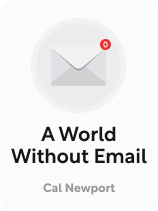

This article is an excerpt from the Shortform book guide to "A World Without Email" by Cal Newport. Shortform has the world's best summaries and analyses of books you should be reading.
Like this article? Sign up for a free trial here.
Is your performance suffering at work? What business workflows can make you happier at work?
In A World Without Email, Cal Newport recommends instituting business workflows to enhance your performance and happiness at work. These systems include using task boards and automating processes.
Keep reading to learn how these workflows can help you become a better employee.
The Process Principle
The process principle is the idea that companies should institute processes—systems and business workflows—that enhance the performance of knowledge workers and make their work more enjoyable.
(Shortform note: Newport’s choice of the word “process” may seem arbitrary because “process” is a loose term that doesn’t in itself communicate much about this idea. However, a formal definition of a “work process” is a system that generates value for a company. This additional context clarifies the principle somewhat—perhaps an alternative, more specific name for it could be the “value-generation principle.”)
Newport feels that many companies fear instituting structured processes for their knowledge workers because these reduce the autonomy and flexibility considered integral to effective knowledge work. In reality, while structures may marginally reduce autonomy and flexibility, they more importantly keep the workplace equitable and efficient: Without formal processes, humans tend to try to do as little work as possible, and influential employees pawn work off on hard-working colleagues.
(Shortform note: The freelancer might be more familiar than anyone with the need to balance autonomy and flexibility with discipline and processes to be optimally productive. Freelancers understand that while autonomy is nice, if you don’t institute certain processes and rules for yourself, you’ll never get anything done. More likely, you’ll abuse your “future self” by procrastinating or forcing yourself to work on weekends to meet deadlines.)
Newport recommends two business workflows in particular: task board-based and automated. Let’s look at both.
The Task Board
Task boards are digital or physical boards displaying columns that represent stages of a project, with cards that represent tasks in those stages. Newport points to Scrum and Kanban as commonly used business workflows tracked with task boards. Scrum is a system software developers often use that involves focusing exclusively on one task or project during a two-week “sprint.” Kanban, on the other hand, is a system more appropriate for regular tasks and projects that must move through a series of stages to completion.
(Shortform note: A new type of task board-process has emerged for those for whom neither Scrum nor Kanban works perfectly: Scrumban, which, as the name suggests, is an amalgamation of the Scrum and Kanban approaches. Scrumban uses sprints—periods of time dedicated exclusively to one project—to organize work (like in Scrum) but also uses the boards more common to Kanban to visualize the work and tasks.)
For instance, you might have an “In Progress” column, a “Testing” column, and a “Backlog” column. Adjust these columns to suit your needs and if in doubt, start with standard “To Do,” “Doing,” and “Done” columns and expand from there. Newport also recommends creating a “To Discuss” column in which you can collect items you need to discuss with others and then hold a meeting with them to cover them all at once.
(Shortform note: The philosophy behind the Scrum and Kanban workflows hinges on adaptability: Both flows let you identify the best stages for your project and agilely move tasks between stages. Indeed, Scrum as a process is constantly being updated by its creators, Ken Schwaber and Jeff Sutherland. You can see these updates in their Scrum Guide. Newport would likely approve of such periodic improvements to existing processes—his recommendation to add a “To Discuss” column, for instance, bespeaks his eagerness to optimize over time.)
In these stage columns, you’ll place and move task cards. Describe tasks clearly on the cards, note who’s responsible, and attach any additional documents needed. If you’re using a digital task board, hold written conversations about the task in the chat or discussion area of the task card rather than via email. This eliminates the need to review a general inbox (and the potential to become distracted by a myriad of other requests). It further keeps expectations of communication low because, unlike messenger apps and inboxes, which people check almost constantly, no one checks project boards constantly.
(Shortform note: Newport advocates capturing all details of a task—such as a description and additional documents—on cards. But what if you don’t have all the details about the task when you create the card for it? A solution to this might be to follow David Allen’s approach in Getting Things Done: Do a physical and mental sweep for all your outstanding tasks and any information you have about them. Write that information on your task board—perhaps in a column titled “To Act On.” Once you have all task information in one place, you can create each task card and be sure it includes all relevant details.)
Hold short, regular in-person meetings with your team to update a board together. Such meetings allow for everyone to provide updates on the status of their tasks, for new tasks to emerge, and for people to be assigned to them. Such meetings promote accountability to the team, involve everyone in decision-making, and eliminate the ambiguity of written communication.
(Shortform note: Some experts think the brief, in-person meetings that Newport recommends are an idealistic solution, and they don’t work in reality. This is because such meetings tend to become longer and longer over time, and participants become disengaged. However, a counterintuitive alternative to the regular update meeting might work: Holding daily hour-long “meandering” meetings that prioritize social connection over efficiency. According to a company that uses this approach, this makes everyone more efficient during the day and reduces later interruptions.)
Automated Processes
If there’s a task you or someone else on your team does frequently (30 or more times a year), automate that task by setting up a business workflow in which all parties know exactly how to handle each step without further communication, writes Newport. This takes time to optimize but always saves time in the long run. You can automate a process in the following steps:
- Break the task into multiple sequential phases, specifying who should do what work.
- Find a way to indicate when a task is done in a phase and is ready to move to the next.
- Have a clear place where files can be passed from one phase to the next.

———End of Preview———
Like what you just read? Read the rest of the world's best book summary and analysis of Cal Newport's "A World Without Email" at Shortform.
Here's what you'll find in our full A World Without Email summary:
- How email makes knowledge workers less productive and more unhappy
- How to improve the channels through which people communicate
- Why you should implement protocols to reduce unnecessary work






